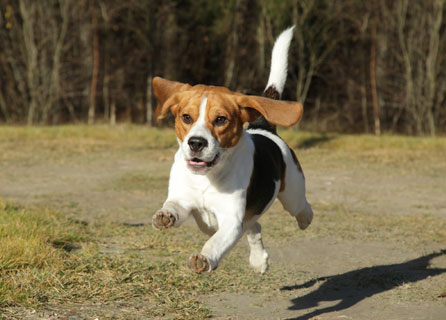
Beagle breed guide
Learn more about these enthusiastic, lively and playful dogs, from their grooming and exercise needs, to the things you can do to keep them happy and healthy.
Breed information and advice
Beagles belong to the hound group, which means they use their nose a lot. They’re sociable, enjoy being around people and are well suited to living with a large family. Here's more you should know.
- One of the most vocal breeds, this dog will always have something to say - whether alerting you to a visitor or asking you to play.One of the most vocal breeds, this dog will always have something to say - whether alerting you to a visitor or asking you to play.
- A Beagle will shed mostly in the spring, so you’ll need to brush their coat weekly to get rid of excess hair.A Beagle will shed mostly in the spring, so you’ll need to brush their coat weekly to get rid of excess hair.
- This dog will typically weigh between 8kg and 14kg, when fully grown.This dog will typically weigh between 8kg and 14kg, when fully grown.
- A healthy Beagle will usually live between 10 and 15 years.A healthy Beagle will usually live between 10 and 15 years.
Typical size of a Beagle: Small: 34cm-40cm

Recommended exercise and nutrition
Your Beagle is an energetic and enigmatic dog, who will typically need up to one hour of exercise each day. They'll usually be nose to ground exploring and investigating all the exciting smells they discover on their walk along the way.
It's important to make sure you train your puppy from an early age, as Beagles are known for being head-strong and difficult to retrieve once off the lead and tracking a smell.
Feed them twice a day with high-quality food - the quantity will depend on their size and age - and always read the label. Make sure they get enough exercise or they could become overweight.
Up to one hour of exercise per day
Up to one hour out together will give your Beagle all the time they need to get the excitement out of their system.

Common health problems and illnesses
There’s no reason why your Beagle shouldn’t live a long and happy life. However, being aware of the ailments your dog will be more prone to, along with the associated symptoms, can help you to deal with any health issues that crop up.
Beagles can be susceptible to epilepsy, where the brain becomes overactive and sends confused signals to the body, resulting in twitching, fits and seizures. While it's distressing to witness your dog experiencing an episode like this, a vet can often prescribe treatment or medication that will help to control the condition.
There are several reasons why Beagles experience lameness, and most are fairly common. Limping can be brought on by insect or animal bites, or injury or it could even just be a case of over-tiredness or old age. Look out to see if your dog is putting less pressure on a hind leg, or has slowed his movement.
Just like their owners, dogs can get diabetes – with Beagles being one of the breeds at risk. If the pancreas doesn’t produce enough insulin, the brain will not know when the body has had enough to eat. Look for increased appetite, unexplained weight loss, tiredness and excessive thirst as warning signs. Your vet can advise on the best treatments, which could include changes to your dog’s diet or insulin injections.
Beagles can be prone to a variety of skin conditions. Warts, growths and lumps can occur as a result of an allergy for example, or a flea bite. Fatty deposits called lipomas could also develop. Feel for unusual bumps when grooming your dog, as most of the time these can be easily treated with medicated skin cream.
Cushing’s disease, where a tumour causes glands to produce too much of the hormone cortisol, can develop in Beagles. Contact your vet if your dog shows signs of advanced aging such as thinning of skin, hair loss or frequent urination, as this disease can usually be well controlled with the right treatment.
Find out about insurance for your Beagle
Learn how pet insurance works and what kind of cover you might need for your dog.
Grooming advice
Your short-haired Beagle won’t need too much care with their coat; just be sure to give them a brush every week to reduce tangling and matting, and keep them comfortable. Always brush down to the skin to ensure you’re stimulating hair follicles that will encourage shedding.
That said, due to their keen sense of adventure and depending on how mucky they get, your dog may need a bath more frequently than others. Every 8 to 12 weeks should do it.
One other area that will need your attention is their teeth, and you should brush these at least once a week to ensure they stay free from plaque build-up and tartar. Nobody really likes a trip to the dentist – not even your dog, but special toothbrushes and toothpastes are available so you can be sure they get their oral hygiene fix.
Fun and interesting facts
- One of the most famous dogs in pop culture is a Beagle - Snoopy from the Peanuts series of cartoons.
- Singer Barry Manilow had a Beagle called Bagel, who appeared with him on one of his album covers.
- Beagles hate being left alone - it’s a genetic thing.
- Your dog’s sense of smell is so keen they can sniff out bed bugs - and this breed is trained to do exactly that.
- An early predecessor to the Beagle can be traced back to Ancient Greece.
Important information
The content on this page aims to offer an informative introduction to pet breeds, but does not constitute expert veterinary advice. If your dog or cat falls ill or has an injury, contact your vet immediately.
All facts and figures were correct at date of publication and were compiled using a range of sources.
Discover more breeds
Browse our other cat and dog guides to learn about some of the UK’s most popular breeds.